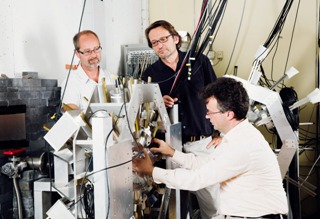Oct 19 2015
Physicists at the TU Darmstadt have succeeded in observing an extremely rare radioactive decay for the first time ever.
 Professor Norbert Pietralla, Professor Thomas Aumann und Associate Professor Dr. Heiko Scheit (from left to right). Image: Katrin Binner
Professor Norbert Pietralla, Professor Thomas Aumann und Associate Professor Dr. Heiko Scheit (from left to right). Image: Katrin Binner
The unusual thing about it is that this so-called double gamma decay of an excited nucleus state, which represents a higher order process, takes place although the first order process is not prohibited by the conservation of energy and momentum laws or quantum-mechanical selection rules. The experimental proof has now been published in the scientific journal "Nature".
A team led by Associate Professor (PD) Dr. Heiko Scheit and Professors Norbert Pietralla and Thomas Aumann of the Institute for Nuclear Physics (IKP TU Darmstadt) has succeeded in detecting a radioactive phenomenon that is exceptionally difficult to observe. Radioactivity is in some sense similar to giving birth: an atomic nucleus emits a particle or a photon (radiation particle). On extremely rare occasions, a nucleus will produce twins, whereby two identical particles or photons are emitted from the nucleus of the atom at precisely the same time.
Previously, this had only been observed in relation to double beta decay in which two electrons (positrons) and two anti-neutrinos (neutrinos) are emitted simultaneously, and double gamma decay, an analogous phenomenon involving highenergy gamma radiation. This process had already been predicted in 1930 by the later Nobel Laureate Maria Göppert-Mayer. Whenever a nucleus emits a photon, it undergoes a quantum jump, losing energy in the process.
This energy is carried away by the emitted photon. In rare cases, as Göppert-Mayer predicted, the energy is distributed among two photons emitted simultaneously in the so-called double-photon decay process. As Scheit explains, processes involving two photons, i.e. not only the decay but also the excitation of an atom, are now routinely observed and applied in the field of atomic physics. Until now, however, nuclear physicists have only succeeded in observing the double-gamma decay in three very special cases, in all of which the single-gamma decay is prohibited by quantum mechanical selection rules. This process has never been observed in cases in which simple gamma decay is allowed.
“Since the 1980s, all attempts to demonstrate double gamma decay in competition with normal single gamma decay have failed”, Pietralla
explains. There are instruments available that only register photons if they Seite: 2/2 are ‘born’ simultaneously, however, because a large number of nuclei in the tested samples decay at the same time, the actual phenomenon of interest, i.e., the emission of twin photons from a single nucleus, has been lost in the crowd, like a real pair of twins in a city of one million souls. In addition, it is possible for a photon to be registered by the first detector and, due to a scattering process at the speed of light, to arrive at the second detector within a few billionths of a second, where it is registered again. That can also mimic the presence of a twin particle.
The research team at the TU Darmstadt managed to solve both of these problems with newly developed gamma radiation detectors, funded by the German Research Foundation (DFG). The special property of these devices is that, not only can they determine the energy of a photon with extreme accuracy, they can also detect time differences of just a few hundred pico seconds (a few ten billionths of a second). Walz and his colleagues constructed a ring of several of these detectors, in the centre of which they placed a substance, which emits gamma rays at a precisely determinedenergy level.
The detectors were triggered if they registered two photons within a very short timespan of just a few nanoseconds, whose combined energy equalled that of the quantum jump. And sure enough, they actually did succeed in detecting the twin photons using this method. “They come into existence at a rate of about one per million gamma decays”, Pietralla reports.
Because the time window is shorter than the time it would take a scattered photon to move from one detector to another at the speed of light, the physicists were able to exclude the possibility that their measurements were an artefact of the system set up. With the aid of his colleague Vladimir Ponomarev, Walz has also been able to provide a quantitative explanation for the measured values on the basis of a theoretical model. Incidentally, Professor Pietralla’s collaborator Dr. Christopher Walz was awarded the 2014 Dissertation Prizes of the TU Darmstadt and the European Physical Society for the discovery.
This work has been supported by the State of Hesse in the scope of the Helmholtz International Center for FAIR (HIC for FAIR) and by the German Research Council (DFG) under grant No. SFB 634.